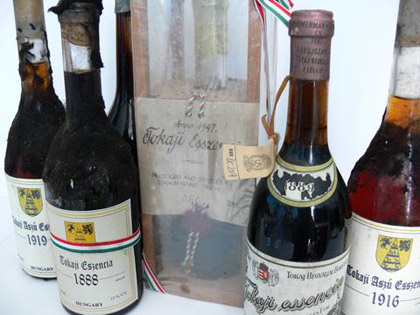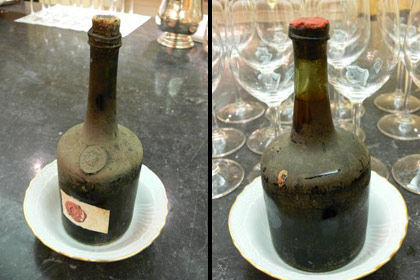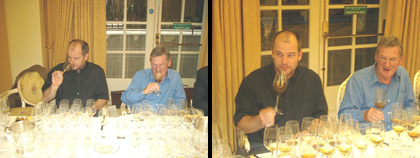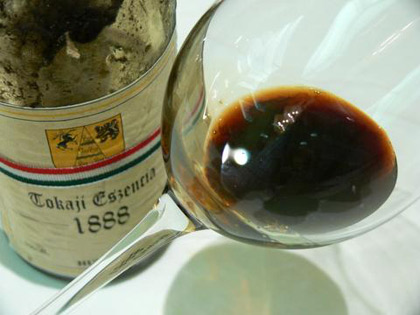London and wine? Is it possible that one of the largest and most interesting wine metropolises is located in a country with just 1,000 hectares of vines? Yes! England has a very long history around wine and its trade. Tokay, however, has never been the wine of London, past or present.
The wine scene in London is one of the most fascinating in Europe, perhaps in the world. Extraordinary wine tastings take place almost daily. Countless wine clubs help it to have a vibrant wine life. The invitation to a Tokaj tasting with 18th century Aszú wines is, even by London standards, quite extraordinary.
 |
| 14%-- per millilitre - two to three can be had |
The crowning glory of Tokaji Aszú, the noble sweet wines from Tokaj, is the Eszencia - not to be confused with an Aszú Eszencia. The similar-sounding names very often lead to confusion between these two specialities. Sensory-wise, the Eszencia has a much higher sweetness, an almost black colour and is viscous like honey. The juice can contain up to 80% sugar. Which in turn means that fermentation can take up to 20 years and even then only yields 2-4% alcohol. Aszú does not mean the wine itself, but the condition of the grapes when they are harvested. Dried and raisined.
The juice, which runs off the press by itself and without pressure, is the basic ingredient of the later Eszencia. Highly concentrated and sweetest juice from rosinated grapes, which is collected drop-wise. Only in the most exceptional years and in the smallest quantities are these wines produced. A nectar in its purest form. Such wines are almost indestructible, but the prices to be paid destroy many a wine lover's wish to ever taste such a wine. In earlier times, brandy was often added to make the wines more drinkable.
The two main protagonists of this epochal wine tasting were two bottles from the "Royal Saxon Wine Cellar". Originally there were three bottles, one of which had been auctioned off at Christie's in London a few weeks earlier for 7,485. With a content of 0.5 litres, that is almost 14,-- for the millilitre. You can treat yourself to two or three millilitres.
Origin of the bottles
Where do such bottles come from and what have they experienced? As in the case of our two bottles, it is not always possible to trace them exactly. A Mr Dennis Weathley auctioned off part of his wine cellar in 1968, Michael Boadbent MW was the auctioneer at the time. One bottle with the Royal Saxon crossed swords and the word Hofkellerei was estimated by experts to be dated 1649. Exactly the same on the outside is our bottle with the red wax seal on it, see right picture below, means it could be from that year. It is more likely that our bottles came from an auction in Dresden in 1927. At that time, 62 Tokays from the royal Saxon wine cellar were auctioned, 49 of which dated from 1718 to 1749. This historical development is fascinating and brings history and wine to life and makes them flow into each other. The oldest wine from the Fukier collection, for example, a Tokaj collection known among experts, is said to date back to 1606, but this collection of several hundred bottles has never turned up until today.
 |
| What does a wine taste like that is over 200 years old? |
The Schnapsgustl
Alfred Ungermann was the butler of the last Saxon king, Friedrich August III, and thus an intimate connoisseur of royal drinking habits. He told the following story about Princess Mathilde, the king's sister: "We called her Schnapsgustl, because of her fondness of a good bottle of wine. I often had to go down to the royal cellar to bring her a bottle of Tokay". A wonderful little story around that, and imagine if the princess had got wind of her nickname. Surely the royal Schnapsgustl has already pre-tasted the wines in our sample, a royal taster, so to speak.
Anticipation and questions
But how does a wine that is over 200 years old taste? Is it still drinkable or just vinegar? What does a wine that old look like? How does it feel to have a wine in the glass whose grapes were perhaps harvested during the French Revolution?
That's why we, Jürg Richter and I, were excited to bursting when we landed at London Heathrow. Everything was very well prepared. The hotel to the tasting venue only a 3-minute walk away, London Tube connections printed out beforehand and still time to eat something beforehand. This is urgently needed, as the extreme acidity and sugar levels have made many a taster throw in the towel.
Who had the honour?
One of the participants in the tasting was Hugh Johnson, who needs no further introduction. As a partner of a winery in Tokaj, he is virtually predestined for such an evening. He knew how to add to the tasting with many details and had lively discussions with us at the table, an incredibly nice contemporary to boot.
Also present were Jürg Richter, a renowned Sauternes and Tokay expert from Switzerland, Neal Martin, a well-known wine journalist from London who can be found at almost every interesting wine tasting in the vicinity of the British capital, and Frank Strzyzewski. He has been writing a book about Tokaj for 10 years and is therefore a valuable source of information. He has also written a travel guide about Budapest.
The wines
The wines were poured one by one and then discussed. It started with a wine from Hugh Johnson's private cellar. He thought it must be a 3-butt Royal Tokaj from around 1930, which more than surprised with a still distinct malty sweetness. It was followed by a 1919 Aszú-Esszencia, which had only recently been released by the state wine museum and was therefore freshly corked. This was followed by the same wine from the 1916 vintage. Both very different in quality.
The worst wine of the evening was then a 1904 Tokay Ausbruch Hofkeller from a Viennese merchant.
Now came the ones we had all been waiting for, the two from the 18th century. Again, on very different levels. Both wines were liquid history, one in top form, the other rather far above its zenith.
 |
| critical "moments"....? here both seemed to enjoy it....! |
Next came the extremely sweet and concentrated Eszencias. First there was a 1947 Tokaji Eszencia from the Tokaji Wine Trust. Followed by Eszencias from 1888 and 1889, again extremely different in the way the wines presented themselves. The 1888, already retired for a few decades, will surely survive another 118 years and still be a pleasure to drink. In the past, a spoon was served with such a wine, which makes a lot of sense to me.
Classic or modern?
Last but not least, seven wines from the years 1993 to 2000 came into the glass. The comparison of the classic version, with its typical oxidative note, with the modern, very fruit-driven style, was extremely revealing. For me, the former is clearly the more complex and finesse-rich wine. More depth and above all a clear typicity. From my point of view, the modern version goes in the direction of international style, with a lot of exotic fresh fruit, and thus loses its independence. One could definitely make associations with a Sauternes in one of the wines. In another, the barrique was palpable - something like this makes wines much more uniform than some of the oenological processes that are currently being criticised. Autonomy is something that many wine-growing regions are struggling for these days and envy others for. Such regions have to work hard to achieve it. Jürg Richter, along with a few others, advocates the more modern style of vinification. From the point of view of marketability, this is an argument that cannot be dismissed out of hand. If the - perhaps only fashionable - better saleability is at the expense of independence, this is perhaps a bit short-term thinking.
The tasting notes
General impressions
The wines changed constantly in the glass, they almost all got better with air. The 1930 from Hugh Johnson's cellar was at first mouldy and oxidised, then blossomed, then almost collapsed and was much better again by the end of the tasting. All the wines, especially the 1888, 1889 and of course the two mid-1800s seniors, produced goosebumps and transported us to another era. I always imagine what it was like more than two centuries ago - the people who brought in the harvest, the means by which they produced the wine - what would it be like if these people could taste the wine today, one could go on endlessly. I would have loved to have been there back then.

Ca. 1930 "Royal Tokaji" 3 buttery - from Hugh Johnson's cellar
Very cloudy, tawny-coloured, oxidised at first, talcum, similar to ripe Madeira, toffee, some depth, alcoholic. On the palate fresh acidity, medium malty sweetness, relatively good balance, caramel, also here the Madeira touch, certain elegance, rather short finish, wine collapses after 15 minutes - after about 1 hour it blossoms again. For a 3-butters wine absolutely great.
1919 Ascú Esszencía - State Wine Museum, recently released for sale.
Open & deep nose, roasted nuts, rock candy, prunes, also something dull & musty, with air coffee, a bitter note and cognac aromas come in. Nice sweetness-acidity balance, clear acidity, bitter almonds, roasted nuts, long and elegant finish. Changes a lot during the tasting. Wonderfully ripe wine with character.
1916 Ascú Esszencía - State Wine Museum, recently released for sale.
Initially very unclean & stinky nose of vomit - but loses itself completely after 5 minutes, then a beautiful cognac nose emerges along with dried dates-bananas-apricots - beautiful, deep & complex. On the palate, clearly more acidity & sweetness than 1919, seems more impressive than 1919 at first. However, both are in opposite corners and not interwoven, little balance. Seems artificial - maybe I'm doing the wine an injustice. Was seen differently by most participants....
1904 Tokay Ausbruch - Hofkeller, Viennese merchant (cork was very deep in the neck of the bottle!).
Stinky, stable smell, ethereal, one-dimensional and then oxidised. Breaks in the glass within 10 minutes, sharp & extremely volatile acidity,
Mid-18th century "Imperial Tokay" - royal Saxon wine cellar [Bottle A]
Oh dear at the beginning...Sharp, plastic, Pattex, a lot of volatile acidity, acid, almost disgusting to call it, after about 2-3 minutes it got a bit better - some sultanas a. tr. leaves came in, salmiak, after about 15 min. the nose got cleaner and cleaner (relatively speaking). Ripe blue cheese. On the palate, initially very short, like the nose, biting acidity, sweaty, flat, hard, after approx. 1 hr. the wine was somewhat enjoyable...the volatile acidity lived up to its name & disappeared for the most part. As a wine enjoyment, not a great one - from a historical point of view, a madness.
Mid 18th century "Imperial Tokay" - royal Saxon wine cellar [Bottle B].
The beginning as with bottle A, only nowhere near as extreme. Clearly cleaner, deeper & more complex, tr. vegetables, some vegetable stock, aldehyde, Madeira character. Then after 15 min. nice sweetness of bitter caramel, hint of dried fruit...apple...good depth & complexity, clearly sweeter on the palate...more complex but with a bit of sharp acidity, became really good after 1 hr. clearly longer finish with tasty caramel sweetness. As a wine and as history really grandiose...a wine with the age of at least 200 years!!!! Pure goose bumps!!
1947 Eszencia - Tokaji Wine Trust, Monimpex export bottle (Pre -1989 export bottle).
Very high viscosity, extremely concentrated nose of pureed sultanas & currants, liquorice, espresso, candied chestnuts come to mind spontaneously, separate bananas - apricots - apple pieces, everything still very young & compact, after approx. 30 min. everything becomes a bit more open - decant one or more days before!!! Massive, on the palate a melon-like, extremely dense & compact sweetness, pure sultanas, grapey muscat aromas, a straight acidity against it, which the wine needs, molasses, darkest forest honey, A monument of a wine. Almost eternal finish. Will last another 100 years. Just an Eszencia.
The wine must have between 500-650 g/l residual sugar!
1889 Eszencia - Zimmermann Lipót és Fiai
At the beginning very discreet and even with an elegant touch, coffee, bitter chocolate, plums, sultanas, malt, a bit of Bailly's liqueur, with air everything becomes more complex and multi-layered - beautiful. Not as beefy as the 47 Eszencia. On the palate less sweetness than expected (relatively speaking), creamy, caramel sweets, cognac type, candied fruits, very ripe but compact acidity, clearly noticeable alcohol (was often added at the time) - but gives the wine a lightness & elegance - has something incredibly animating, seems like an Ascú Esszencía in terms of weight. A very long, finesse-rich finish.
1888 Esszencía - state wine museum, recently released for sale.
Pouring it was pure sensation: without exaggeration it flows like honey into the glass. To swirl the wine in the glass, move the glass around the horizontal axis on the table. It takes the 47 to at least another level. Lasts an eternity, both in the bottle....glass...carafe. Probably no more than 2% alcohol. Loads of flavours, it's enough for 1-2 sips.....for the evening. I wrote almost nothing down, just enjoyed it. See note of the 47 only concentrated everything to the extreme!!! Liquid sultanas and grapes, syrupy.....
2000 "Blue Label" 5 puttonyos - Royal Tokaji
Fresh clear aromatics, cool mint, some menthol, fresh apricots, vanilla and buttery, floral and slightly mineral in the background. Good combination of freshness and Tokaj sweetness on the palate, bright exotic fruits, very long, with finesse. Class.
2000 Tokaji Aszú 6 puttonyos - Gróf Degenfeld
Very open nose, clear citrus fruits - lemon, lime & grapefruit, very compact and youthful, with air some orange peel & vanilla comes in. Modern style. Relatively little sweetness on the palate, clear acidity, fresh and fruity, again exotic bright fresh fruits, juicy and quaffably balanced. Top made, the new modern style.
2000 Tokaji Ascú Eszencia - Pendits
Rather discreet nose, but then very modern, buttery, creamy, some crème brulée, fresh herbs, touch of oak in the background. Elegant nose. Very good balance on the palate, elegant, relatively well developed and therefore already easy to drink, creamy structure, nevertheless fresh, few boytritis notes, more like a full Sauternes, very good and rather made for medium storage potential (20-30 years). As a wine it is great - as Ascú Eszencia it has little old heritage.
1999 Tokaji Ascú 6 puttonyos - Disznókõ
At first discreet, light aromas of honey, peach, some pear, again this cool mint, but also creamy notes, after about 2 hours darker boytritis aromas appear, like darker honey, some sugar beet syrup, tobacco. On the palate everything very young and compact, fresh high acidity and filigree sweetness, bright dried fruits, some roasted nuts, has style and class. Great potential
1999 Tokaji Ascú 6 puttonyos - Oremus
Very discreet boytritis nose, oxidative style in the background, tobacco box, forest honey, pistachios, compact, dense, needs a lot of air. On the palate ripe acidity, lots of power and density, tr. dates, discreet sultanas, nutty, everything very well balanced but still withdrawn, very long & dense finish. Absolutely classy with great potential.
1994 Tokaji Ascú 6 puttonyos - Szarvas, Crown Estates
Wide developed nose, dark aroma of freshly pressed muscat grapes, malty sweetness, floral notes, fresh tobacco, mingled sultanas and nuts, deep and complex. Great balance on the palate, rather ripe restrained acidity, you can literally taste the dried grapes (just try grapes affected by boytritis - exactly this taste), tobacco can again, some milk chocolate mousse, touch of espresso, very long deep finish. Classic style. In 20 years, surely something to get into. Delightful.
1993 Tokaji Ascú 6 puttonyos - Mézes Mály, Royal Tokaji
More restrained than the 94, rather lighter notes, also touches of exotic fruits in it, becomes more complex at the end of the tasting, although rather restrained, the wine seems very well balanced. Calm, already drinkable with much pleasure, ditto on the palate, lighter and also tobacco notes, something of grapefruit - mirabelles, elegant and delicate. A hybrid between modern and classic but more on the modern side. Great!
Historical events from the older vintages
| 18th century | ||
| Founding of the United States of America French Revolution 1789 Scientific discoveries and early phase of the Industrial Revolution. James Cook circumnavigates the world in the 1770s. Start of European settlement in Australia 1788. Wars of Empire between Britain, France, Spain, Important people: Johann Sebastian Bach, composer James Cook Benjamin Franklin, American inventor and diplomat Frederick II of Prussia Joseph Haydn, composer Thomas Jefferson, American politician Immanuel Kant, German philosopher Catherine II (called: Catherine the Great) Wolfgang Amadeus Mozart, composer Isaac Newton, English physicist Frederick Schiller Voltaire, French writer and philosopher |
||
| 1888 | ||
| The year 1888 went down in history as the year of the three emperors. William I, who died on 9 March, was succeeded by his son Frederick III, who was ill with cancer and succumbed to his ailments on 15 June after a three-month reign. He was succeeded on the same day by Wilhelm II as German Emperor and King of Prussia. 5 August - Bertha Benz drives with her two children in her husband Carl Benz's car (without his knowledge) from Mannheim to Pforzheim. It is the first overland journey by an automobile. Wilhelm Hallwachs discovers the photoelectric effect. |
||
| 1889 | ||
| The Eiffel Tower is built in Paris to mark the centenary of the French Revolution. World's Fair in Paris A republic is proclaimed in Brazil |
||
| 1904 | ||
| Start of the Russo-Japanese War. Formation of the Entente between Great Britain and France. World's Fair in St. Louis, Missouri, USA - Louisiana Purchase Exposition, the Lousiana Monument. Start of the Summer Olympics in St. Louis, Missouri, USA. US Army engineers build the Panama Canal (until 1914). Born Kurt Georg Kiesinger, German politician and Chancellor ( 1988) Robert Oppenheimer, US physicist ( 1967) Salvador Dali, Spanish Surrealist painter ( 1989) |
||
| 1916 | ||
| The Battle of Verdun claims 700,000 dead, wounded and missing. The Battle of the Somme leaves more than 1 million dead, wounded and missing The longest railway line in the world, the Trans-Siberian Railway, is completed. Born Yehudi Menuhin, US-American violinist ( 1999) François Mitterand, French President ( 1996) |
||
| 1919 | ||
| Hungarian soviet republic First non-stop flight across the Atlantic by John Alcock and Arthur Whitten-Brown 22 June Signing of the Treaty of Versailles The Weimar National Assembly gives Germany a democratic parliamentary constitution. Ernest Rutherford artificially converts nitrogen into oxygen: 147N + 42He -> 178O + 11H Foundation of the League of Nations |
||
| 1930s | ||
| World economic crisis, mass unemployment until the mid-1930s Fascist change of power in Germany - Adolf Hitler - 1933 Spanish Civil War (1936-1939) Beginning of the 2nd World War (1939) |
||
| 1947 | ||
| 1 January - Foundation of the "Bizone": The American and British occupation zones are combined into a single economic area. The French zone is joined later. | ||